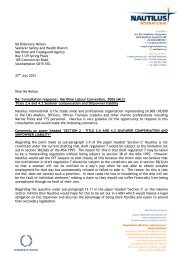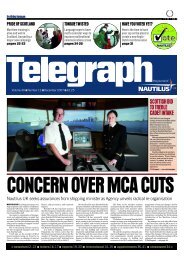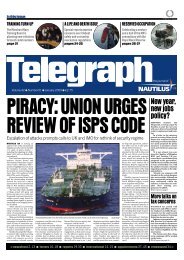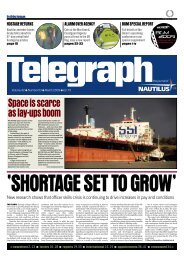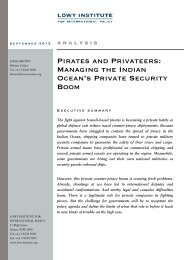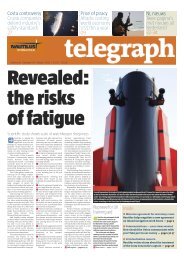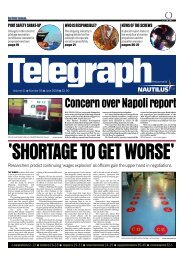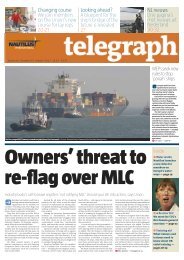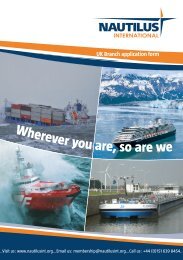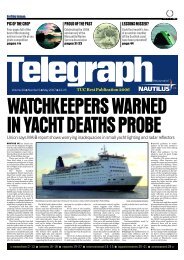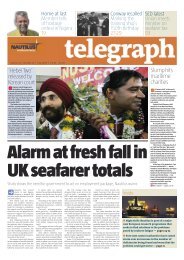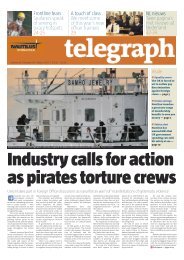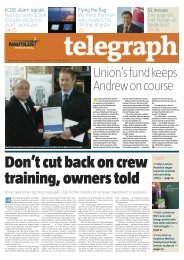NAUTILUS P01 OCTOBER 2010.qxd - Nautilus International
NAUTILUS P01 OCTOBER 2010.qxd - Nautilus International
NAUTILUS P01 OCTOBER 2010.qxd - Nautilus International
Create successful ePaper yourself
Turn your PDF publications into a flip-book with our unique Google optimized e-Paper software.
October 2010 | nautilusint.org | telegraph | 19<br />
SAFETY AT SEA<br />
Some 2,300 passengers on<br />
the Jewel of the Seas took<br />
part in the latest Project<br />
Safeguard trials<br />
Order, order!<br />
Spotlight on<br />
evacuation<br />
EU-funded research into passenger responses in an emergency could help<br />
to rewrite the international evacuation rules for cruiseships and ferries…<br />
A<br />
The phenomenal growth<br />
of the passenger shipping<br />
industry over the<br />
past 20 years has been matched<br />
by massive increases in the capacity<br />
of cruiseships and ferries —<br />
in turn generating growing<br />
concerns about safety.<br />
<strong>Nautilus</strong> has been among a<br />
number of organisations highlighting<br />
the potential problems<br />
of evacuating vessels carrying as<br />
many people as a small town and<br />
providing suitable search and<br />
rescue resources — often in<br />
remote areas.<br />
A three-year European Unionfunded<br />
research project — Safeguard<br />
— is now under way in an<br />
attempt to address some of these<br />
concerns. And, as part of this work,<br />
a research team led by the University<br />
of Greenwich recently carried<br />
out what must surely rank as one<br />
of the biggest-ever experiments<br />
in ship evacuation and safety procedures.<br />
The University’s fire safety<br />
engineering group staged what<br />
was described as a unique and historic<br />
trial onboard the 90,090gt<br />
Royal Caribbean vessel Jewel of<br />
the Seas, in which more than<br />
2,300 passengers took part in a<br />
‘live’ assembly drill while at sea.<br />
Passengers’ response times<br />
once the evacuation alarm<br />
sounded were measured by 100<br />
video cameras — which included<br />
CCTV, fish-eye, digital and analogue<br />
cameras — carefully positioned<br />
by the research team.<br />
Passengers also wore specially<br />
developed infra-red tracking tags<br />
throughout the half-hour exercise,<br />
which allowed researchers to<br />
locate each person’s exact movements<br />
and reconstruct the paths<br />
passengers took as they made<br />
their way around the ship to the<br />
various muster points onboard.<br />
Professor Ed Galea, head of the<br />
research team, said the findings<br />
could help to set the benchmark<br />
for future regulation. ‘This assembly<br />
trial was unique in several<br />
aspects, as we collected data from<br />
a large cruiseship, during a virtually<br />
unannounced assembly drill<br />
and while we were actually at sea,’<br />
he explained.<br />
‘The research measured realistic<br />
response times to the alarm, at<br />
a time when 2,300 passengers were<br />
spread over 12 decks. Although<br />
passengers had been told the day<br />
before that we would be doing<br />
a drill, they were largely unprepared<br />
— in their staterooms, in<br />
the bars, in the gym, in the shops,<br />
restaurants and elsewhere — as<br />
the alarm sounded.<br />
‘All of this represents a significant<br />
difference from a typical<br />
assembly trial, which is heavily<br />
announced beforehand, which<br />
takes place before the ship sails,<br />
and where many of the passengers<br />
are already at the assembly<br />
points simply waiting for the drill<br />
to begin.’<br />
The trial onboard Jewel of the<br />
Seas was the third carried out by<br />
the University of Greenwich team.<br />
Two took place last year onboard<br />
a Color Line ferry with 900 passengers<br />
onboard, while two more<br />
will take place early next year<br />
onboard a Minoan Lines ferry that<br />
carries passengers in cabins.<br />
All of the data collected in these<br />
trials will be used to assess how<br />
long it takes passengers to react<br />
to the alarm being sounded and<br />
to start to move to a muster station.<br />
Researchers will also analyse<br />
the way in which they get to muster<br />
points, and the factors that<br />
influence their actions — such as<br />
whether they are in their cabin,<br />
Top: passengers move to the muster stations onboard<br />
Jewel of the Seas. Above: members of the Project<br />
Safeguard research team Pictures: University of<br />
Greenwich<br />
eating a meal, or in a group.<br />
‘When you measure all the<br />
response times for different activities<br />
you get a distribution and we<br />
have found quite significant difference<br />
in response times,’ Prof<br />
Galea said.<br />
The €3.5m Safeguard project is<br />
also using computer simulations<br />
to evaluate the effectiveness of<br />
Tagged: specially-developed infra-red tracking devices<br />
used in the trials Picture: University of Greenwich<br />
“<br />
Nothing on this<br />
scale is likely to be<br />
attempted again<br />
”<br />
existing ship evacuation models<br />
and the results should help to<br />
determine whether <strong>International</strong><br />
Maritime Organisation policies<br />
need to be changed.<br />
The project involves partners<br />
from countries including the UK,<br />
France, Norway, Finland, Greece<br />
and Canada. As well as the University<br />
of Greenwich, its members<br />
include the BMT Group, Principia,<br />
Safety at Sea, Bureau Veritas, the<br />
Marine Institute of Canada, Royal<br />
Caribbean <strong>International</strong>, Color<br />
Line and Minoan Lines.<br />
Safeguard builds on earlier<br />
research work — the Fire Exit<br />
project — which demonstrated<br />
that the response time data used<br />
as the basis for the IMO evacuation<br />
analysis protocol was not<br />
rich enough to accurately represent<br />
reality and failed to provide a<br />
suitable basis either for the use of<br />
evacuation simulation programs<br />
or for their validation.<br />
By developing this research<br />
further and obtaining detailed<br />
data on passenger response times<br />
and assembly times, Project<br />
Safeguard aims to result in an<br />
improved new version of the<br />
existing IMO circular, 1238.<br />
Prof Galea said that the scale of<br />
the operation onboard the Jewel<br />
of the Seas was vast. The exercise<br />
required nine months of planning,<br />
while at least six months<br />
will also be needed for frameby-frame<br />
analysis of the video<br />
footage, to measure the reaction<br />
times of passengers as they made<br />
their way to assembly points.<br />
Questionnaires filled in by passengers<br />
onboard at the time of the<br />
drill will also provide extra data<br />
for the researchers to analyse.<br />
The intense preparation paid<br />
off, however, as nearly all passengers<br />
cooperated with the<br />
assembly drill and wore their tags<br />
throughout the exercise. ‘We had<br />
been worried that ship operators<br />
might think we would annoy the<br />
passengers, but what we found<br />
was quite the opposite,’ Prof Galea<br />
told the Telegraph.<br />
‘They were extremely supportive<br />
and quite a lot came up<br />
to us and thanked us for doing it<br />
and looking after their safety,’ he<br />
added. ‘The senior members of<br />
the crew that we dealt with were<br />
also really helpful and behind<br />
what we are doing, and without<br />
their cooperation we could not<br />
have done what we did.’<br />
Tracy Murrell, Royal Caribbean’s<br />
director of maritime safety<br />
and compliance, commented: ‘We<br />
are extremely pleased with the<br />
success of the exercise onboard<br />
Jewel of the Seas. The shipboard<br />
team embraced the spirit of<br />
the exercise and assisted in all<br />
aspects to ensure flawless execution.<br />
Royal Caribbean is proud<br />
to be part of the ongoing efforts<br />
to improve safety onboard passenger<br />
ships and looks forward to<br />
learning from the results of the<br />
project.’<br />
Prof Galea described the<br />
work onboard Jewel of the Seas<br />
as ‘exhausting and exciting’ and<br />
said the results will be far-reaching.<br />
‘The response time data and<br />
the validation data we collected<br />
from the project is truly unique,<br />
and will help set an international<br />
standard for ship-based evacuation<br />
models in the future.<br />
‘Nothing on this scale is likely<br />
to be attempted again,’ he added.<br />
‘The research conducted by the<br />
Safeguard team will help shape<br />
future maritime law and, ultimately,<br />
by informing the design<br />
of better and safer ships, will help<br />
save lives.’




